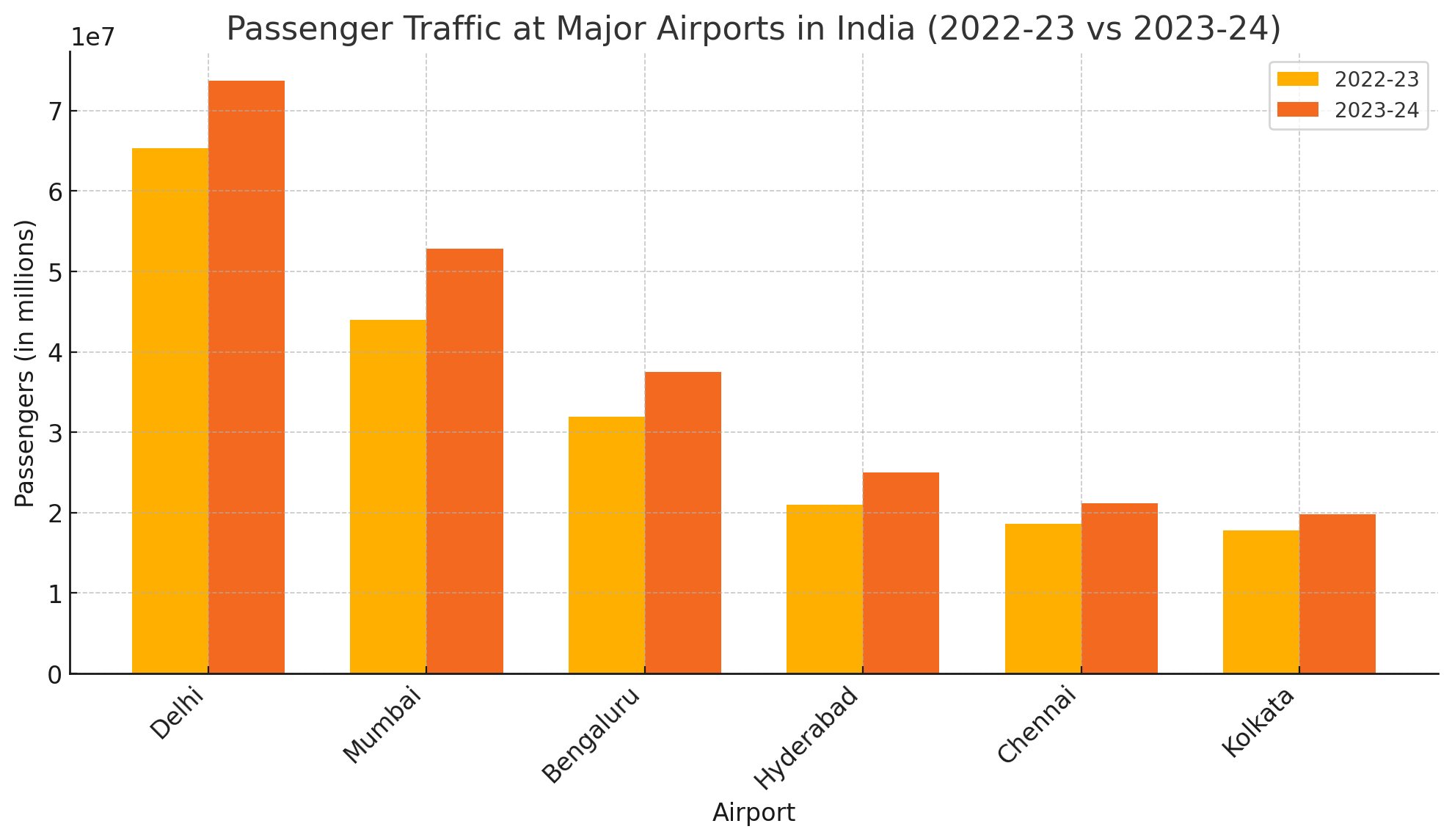India's Aviation Boom: Emergence as the Third-Largest Market and Key Airport Growth
India has emerged as the third-largest aviation market globally, driven by a significant increase in air traffic and expanding infrastructure. Major airports like Delhi's Indira Gandhi International Airport, Mumbai's Chhatrapati Shivaji Maharaj International Airport, Bengaluru's Kempegowda International Airport, and Chennai International Airport are pivotal in handling significant passenger volumes The graph reflects passenger traffic at six major airports in India over two years, 2022-23 and 2023-24. The comparison reveals a significant increase in passenger traffic across all airports, indicating a robust recovery in air travel, likely influenced by the relaxation of COVID-19 restrictions and a resurgence in both domestic and international travel demand.
The graph reflects passenger traffic at six major airports in India over two years, 2022-23 and 2023-24. The comparison reveals a significant increase in passenger traffic across all airports, indicating a robust recovery in air travel, likely influenced by the relaxation of COVID-19 restrictions and a resurgence in both domestic and international travel demand.
Delhi's Indira Gandhi International Airport had the highest number of passengers, with traffic rising from approximately 65.3 million in 2022-23 to 73.6 million in 2023-24. Mumbai's Chhatrapati Shivaji Maharaj International Airport followed, showing an increase from around 43.9 million to 52.8 million. Bengaluru's Kempegowda International Airport also saw a notable rise in passenger traffic, growing from 31.9 million to 37.5 million.
The airports in Hyderabad, Chennai, and Kolkata also experienced increases. Hyderabad’s Rajiv Gandhi International Airport saw a growth of over 4 million passengers, while Chennai and Kolkata had increases of roughly 2.6 million and 2 million, respectively.
Overall, the upward trend across these airports highlights a positive trajectory for the aviation sector in India, suggesting a full recovery and potential for growth. The data indicates increased air travel demand in major metropolitan cities, with Delhi and Mumbai leading. This growth is important for planning future airport capacity expansions, improved infrastructure, and service enhancements to cater to the rising passenger numbers.
The aviation sector in India is witnessing rapid growth, making substantial contributions to the nation’s economy. Government initiatives, such as the UDAN (Ude Desh ka Aam Naagrik) scheme under the Regional Connectivity Scheme (RCS), are focused on increasing air travel accessibility, fostering economic development, and creating job opportunities across the country.
The Indian aviation industry presents a wide range of career opportunities, spanning pilots, cabin crew, air hostess, ground operations, maintenance engineers, and aviation management professionals. With over 1,100 aircraft on order by Indian airlines, the demand for skilled aviation personnel is expected to surge, offering lucrative career options with competitive pay and ample growth potential.
This expansion is expected to create between 250,000 to 500,000 jobs annually, offering diverse career opportunities within the sector.
The growth in air travel accessibility, fueled by initiatives like the UDAN scheme under the Regional Connectivity Scheme (RCS), further stimulates demand for skilled aviation professionals. Jobs in this sector span various areas, including pilots, cabin crew, ground operations, maintenance engineers, and aviation management. The demand for these roles is set to rise sharply.
As the industry expands, it contributes significantly to the national economy by enhancing connectivity, boosting tourism, and supporting ancillary industries. The need for skilled professionals across the aviation value chain, combined with competitive salaries and growth opportunities, highlights the sector's potential to be a major source of employment and economic development in India.
Pilot hiring trend in India:
Data from various Indian scheduled airlines shows that 244 pilots were recruited in 2021. However, the growing aviation market is expected to significantly increase this demand. Industry projections suggest that over the next five years, India will need around 1,000 pilots annually to meet the expanding requirements of the sector. This anticipated rise is driven by the continuous expansion of airline fleets, new domestic and international routes, and government initiatives to enhance regional connectivity. Consequently, this demand presents substantial opportunities for aspiring pilots, as the industry looks to fill these roles to support the booming air travel market.
Source: pib.gov.in
Cabin Crew hiring trend in India:
Air India, as part of its ambitious five-year transformation plan to rejuvenate the airline, recruited more than 5,700 employees in the financial year ending March 31. This includes over 3,800 flying crew members, such as pilots and cabin crew, aimed at bolstering its operational capabilities. In line with expanding its footprint, the airline also launched 16 new routes during the last financial year, with 11 of these being international routes. These efforts are part of Air India's strategy to enhance its global presence, improve service quality, and strengthen its position in the competitive aviation industry, contributing to its overall revival.
Source: economictimes
Internships in Aviation: Bridging the Skills Gap for Aspiring Professionals
To meet the growing demand for skilled professionals in the aviation industry, several institutes are now offering internship programs. These internships provide hands-on experience in various aspects of aviation, such as airport operations, aircraft maintenance, cabin crew services, and ground handling. By integrating practical training with academic learning, these programs prepare students for the dynamic challenges of the aviation sector. The internships are designed to bridge the gap between theoretical knowledge and real-world application, making candidates more job-ready. Such initiatives not only help aspiring aviation professionals gain valuable industry exposure but also support the industry's need for a skilled workforce.











Post a Comment